Yo-Yo Tips and Tricks
Yo-Yo Maintenance
Stringing a Yo-Yo
Trimming the String
String Placement
Winding the String
Oiling a Yo-Yo
Yo-Yo Troubleshooting
Yo-yo not working right?
Find the problem and fix it here!
Choosing a Yo-Yo
To many people, a yo-yo is a yo-yo. There was a time not too long ago when this was largely true. But in the past few years, yo-yos have been designed with technology and physics in mind, creating different yo-yos for different skill levels and styles of play.
So what makes one yo-yo different from another?
There are many characteristics which set one yo-yo apart from the next. Body material (wood, plastic, rubber, aluminum), weight, axle design and material, body shape, and size all play a role in determining how a yo-yo will perform. Of these, shape and axle have the greatest effect on the yo-yo's performance.
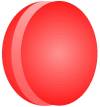 The traditional design is the classic and most common shape for a yo-yo. It is a good all-around shape for most tricks and is good for looping. Most beginners will do well on a yo-yo with a traditional shape like the Brain.
The traditional design is the classic and most common shape for a yo-yo. It is a good all-around shape for most tricks and is good for looping. Most beginners will do well on a yo-yo with a traditional shape like the Brain.
 The flared gap design is basically the two halves of the traditional design reversed. Because of its extra wide string gap, it is an excellent shape for tricks which require the yo-yo to land on its own string, such as Trapeze and Split the Atom. Offstring tricks, where the yo-yo is not attached to the string, are also best performed on a flared gap yo-yo. It is a difficult shape for looping, however. Yomega Saber Wing yo-yos are an example of this shape.
The flared gap design is basically the two halves of the traditional design reversed. Because of its extra wide string gap, it is an excellent shape for tricks which require the yo-yo to land on its own string, such as Trapeze and Split the Atom. Offstring tricks, where the yo-yo is not attached to the string, are also best performed on a flared gap yo-yo. It is a difficult shape for looping, however. Yomega Saber Wing yo-yos are an example of this shape.
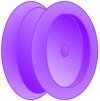 The modified design is the newest of the three shapes. The majority of the yo-yo's mass is distributed around the rim of the yo-yo, allowing for the longest spin, or sleep, time possible. It is also capable of being a good looper. Many modified yo-yos like Bumblebees and ProYos cover the hollow inside with a lightweight paper or plastic cap to give it the more familiar feel of a traditional yo-yo while maintaining the performance of a modified. Modified flared gap yo-yos are also gaining popularity for their long spin times during long, complex string tricks.
The modified design is the newest of the three shapes. The majority of the yo-yo's mass is distributed around the rim of the yo-yo, allowing for the longest spin, or sleep, time possible. It is also capable of being a good looper. Many modified yo-yos like Bumblebees and ProYos cover the hollow inside with a lightweight paper or plastic cap to give it the more familiar feel of a traditional yo-yo while maintaining the performance of a modified. Modified flared gap yo-yos are also gaining popularity for their long spin times during long, complex string tricks.
 A fixed axle has the string of the yo-yo looped around the axle itself. These yo-yos sleep (spin) because the string is attached loosely enough for the axle of the spinning yo-yo to slip in the loop at the bottom of the string. The axle itself does not move.
A fixed axle has the string of the yo-yo looped around the axle itself. These yo-yos sleep (spin) because the string is attached loosely enough for the axle of the spinning yo-yo to slip in the loop at the bottom of the string. The axle itself does not move.
Fixed axles may be made from plastic, wood, or metals such as steel or brass. Most players prefer wood axles for performance, but metal axles for strength. Some modern yo-yos such as the Technic and ProYo have combined the best of both worlds by placing a wood sleeve over a metal axle, and many players use these for their blend of strength and performance in tournaments where fixed axles are required.
Fixed axle yo-yos do not sleep as long as transaxle yo-yos, but can make better loopers. Although you can unscrew the two halves of some fixed axle yo-yos to remove string tangles, many cannot be taken apart, so make sure you know your fixed axle yo-yo can come apart before you try!
String tension, or how tightly twisted the string is, is very important on fixed axle yo-yos. If the string is twisted too tightly, the yo-yo cannot spin in the loop at the end and will not sleep. But if the string is not twisted tightly enough, the yo-yo will not return. Experiment to find the perfect easy sleep - easy return string tension.
 A transaxle is a piece which spins on the metal axle of a yo-yo. The string is attached to this piece. The yo-yo sleeps because the transaxle spins freely. String tension is less important on transaxle yo-yos, although a loosely twisted string does catch inside the yo-yo better for easy returns.
A transaxle is a piece which spins on the metal axle of a yo-yo. The string is attached to this piece. The yo-yo sleeps because the transaxle spins freely. String tension is less important on transaxle yo-yos, although a loosely twisted string does catch inside the yo-yo better for easy returns.
Transaxles may be either a plastic or nylon bearing, or a metal roller bearing. The nylon bearing, such as is found in the Brain and Fireball yo-yos, is inexpensive, but will not sleep as long or as smoothly as the more expensive roller bearing. Yo-yos with nylon bearings require lubrication such as a Teflon oil. Most roller bearings are sealed and require little or no lubrication.
Transaxle yo-yos sleep longer than fixed axle yo-yos, but can be difficult to use in looping due to their tendency to sleep. However, transaxle yo-yos with brake pads or friction stickers, or with adjustable gaps set narrow, can be very good loopers.
A yo-yo string is simply one long string folded in half and twisted up. Remove the old string by untwisting it until you can slip the yo-yo out.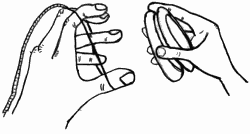
 To put one loop on a yo-yo, untwist the new string at the bottom (the end without the knot) until you have opened up a loop large enough to slip over the yo-yo. Slip this loop over the yo-yo and into the string gap. Now allow the string to retwist while keeping tension on it to avoid kinks, and you're done!
To put one loop on a yo-yo, untwist the new string at the bottom (the end without the knot) until you have opened up a loop large enough to slip over the yo-yo. Slip this loop over the yo-yo and into the string gap. Now allow the string to retwist while keeping tension on it to avoid kinks, and you're done!
For two loops, start with one loop but continue to hold the string open after slipping it into the string gap. Give it a one-half twist and slip the loop over the yo-yo again. For three loops, give it one more half-twist and slip it over the yo-yo again. Retwist the string after you have installed the proper number of loops.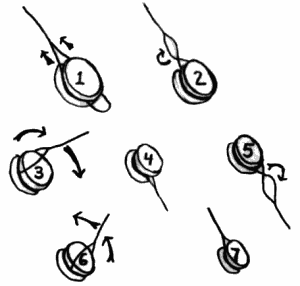
Stringing Guidelines
This should give you an idea how many loops to put on your yo-yo. If you're not sure, start with one loop and add more until your yo-yo both sleeps and comes back easily.
- All fixed axle yo-yos: One loop. Two are preferred by some for looping, and three can be used for very young children so the yo-yo doesn't sleep, making it easier to get it back to the hand.
- Nylon transaxle yo-yos, such as the Yomega Brain: Three loops; two for more advanced players.
- Roller bearing yo-yos: One or two loops.
- Yo-yos with an adjustable string gap: Usually one loop, sometimes two.
Trimming the String and Making a Slipknot

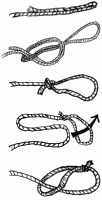 The string should be waist to navel high on the yo-yo player. If it is too long, cut it about four inches above the waist.
The string should be waist to navel high on the yo-yo player. If it is too long, cut it about four inches above the waist.
To retie the loop, fold the top of the string over about an inch and tie a knot near the cut end of the string. Now, pull the string through the loop you just made and you will have a slipknot.
String Placement
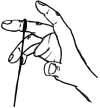 Most yo-yo players wear the string on their middle finger between the first and second knuckles. This provides a good combination of leverage for powerful throws and balance for improved control during tricks.
Most yo-yo players wear the string on their middle finger between the first and second knuckles. This provides a good combination of leverage for powerful throws and balance for improved control during tricks.
Winding the String
With the exception of the Brain, the string can be difficult for beginners to wind, especially with transaxle and roller bearing yo-yos. An easy way to wind your yo-yo is to place your index finger over the string gap and wind the string once over your finger. Next wind the string twice more around, this time under your finger and inside the string gap. Now slip your finger out and finish winding your yo-yo.
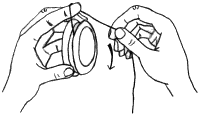

Oiling Your Yo-Yo
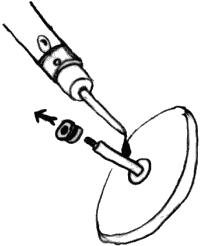 Yo-yos with nylon transaxles (such as Brains and Fireballs) require lubrication when they are hard to get back to the hand or make a screeching noise. To oil your yo-yo, unscrew it and remove the transaxle. Place a drop of Teflon oil on the smooth part of the metal axle, being careful to avoid getting any on the threading of the axle (the yo-yo will not stay together if there is). Replace the transaxle and screw the yo-yo back together, being very careful not to damage it by overtightening.
Yo-yos with nylon transaxles (such as Brains and Fireballs) require lubrication when they are hard to get back to the hand or make a screeching noise. To oil your yo-yo, unscrew it and remove the transaxle. Place a drop of Teflon oil on the smooth part of the metal axle, being careful to avoid getting any on the threading of the axle (the yo-yo will not stay together if there is). Replace the transaxle and screw the yo-yo back together, being very careful not to damage it by overtightening.
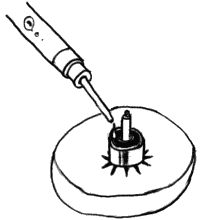 Roller bearing yo-yos rarely require lubrication, if at all, as some use sealed bearings (such as Bumblebees). If you do feel that your bearing yo-yo needs lubrication, place a very small drop of Teflon oil in the groove on the side of the bearing. Normal play will work the oil into the bearing.
Roller bearing yo-yos rarely require lubrication, if at all, as some use sealed bearings (such as Bumblebees). If you do feel that your bearing yo-yo needs lubrication, place a very small drop of Teflon oil in the groove on the side of the bearing. Normal play will work the oil into the bearing.
My Brain won't come back automatically
String: Make sure the string is triple looped and tightly twisted around the transaxle so that it is not slipping.
O-ring: After enough use, the o-ring will wear down from the closing of the clutch around it. If the o-ring seems flat around the edges rather than rounded, replace it. Wipe any oil off the o-ring and clutch.
Clutch: The clutch may be broken so that it cannot close tightly on the o-ring. This can happen if the yo-yo hits the ground hard.
My fixed axle yo-yo won't come back
Twist the string so that the loop is a little tighter around the axle. Replace an old, thin string with a new, fluffy one.
My Fireball/Powerspin/Raider/RBII won't come back
Oil: The yo-yo needs oil to fill the air gap between the axle and transaxle.
String: Check to be sure the string is looped three times on the Fireball or Powerspin. Also, old, thin strings do not work as well as new, fluffy ones.
String Gap: The string gap may be too wide. Be sure your yo-yo is screwed together all the way. It is also sometimes possible to knock or pull the axle nut from its plastic housing inside the yo-yo. If this has happened, it can sometimes be fixed by firmly pushing the two yo-halves together to pop it back into place.
Skill: These aren't beginner yo-yos. If you haven't yet mastered a strong throw, you may simply need to practice or start out with a Brain yo-yo to develop your skills.
My yo-yo won't sleep
String: Be sure the string is looped, not tied around the axle. Look for knots in the string. Untwist the string a little so the axle can spin freely within the loop at the end. Check to see if the string is tangled inside the yo-yo or screwed into the axle threading. If the string is tangled inside a non take-apart yo-yo and you use a paper clip, scissors, or other sharp or metallic object to remove it, be very careful not to scratch the axle or inside of the yo-yo as this will quickly cut through your string.
String Gap: If the yo-yo axle threading has been stripped or a spacer has been lost, the yo-yo may be screwed too far together, not leaving a wide enough space for the free spinning of the bearing or string.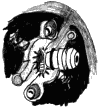 Axle:
Axle:
- Transaxle yo-yo: It may need to be oiled. There may be dirt on the axle. The axle may be scratched, preventing the free spinning of the transaxle or string.
- Brain: The transaxle may be in backwards. Put the o-ring side of the transaxle into the "smart" half of the Brain.
- Adjustable Gap yo-yo: The string gap may be adjusted to too narrow a setting. Widen the gap and try again.
- Roller bearing yo-yo: The pieces may be in the wrong order. Spacers go on both sides of the bearing, cupping around it. Small o-rings, if there are any, go on either side of the spacers.

My string keeps breaking
It is normal for a yo-yo string to break after six to eight hours of play (or less for more advanced players or yo-yos with wood axles), but if your string is breaking after only minutes of play and the yo-yo is a fixed axle yo-yo, the axle may be scratched. A scratched axle will buzzsaw its way through a string very rapidly.
A take-apart yo-yo's string may have gotten caught in the axle threading. If a string falls off a bearing, it will be cut quickly. Check to see that you have all the parts inside the yo-yo and that they are in the correct order. If the yo-yo has an adjustable gap, the gap may have been widened past the width of the bearing.
My yo-yo keeps coming apart or won't screw back together
Threading: It is normal for all take-apart yo-yos to work their way apart over time and should be checked for tightness during play. Wipe any oil off the axle threading and screw the yo-yo back together until it is snug, taking care not to strip the threading or crack the plastic housing.
Stripped: If the axle threading or nut is stripped, or the plastic housing around the nut is cracked, the yo-yo may not screw together or stay together. Don't use too much force when screwing your yo-yo back together and trim your string so you don't hit the ground to prevent this from happening.
My yo-yo won't come apart
Fixed axle: Fixed axle yo-yos like older Duncan models and most wood yo-yos are not made to come apart. Carefully remove string tangles with a paper clip, taking care not to scratch the inside of the yo-yo or the axle.Stripped/cracked: Yo-yos which have been stripped or cracked may not come apart. Don't use too much force when screwing your yo-yo back together and trim your string so you don't hit the ground to prevent this from happening.
My new yo-yo has a mark/knob on the edge
This is the mold mark present on many popular models of yo-yo and is perfectly normal.
My cap fell off
Usually this happens when the yo-yo hits the ground too hard. You can have an adult help you glue it back on with super glue.
I need to take out my axle without scratching it
Although it doesn't work every time, we've had good luck wrapping something like a heavy rubber band around the axle to protect it before using pliers to unscrew the axle from the yo-yo.
Yo-Yo Tips and images ©1998 by Yo-Yoda of Yo-Yo Universe
Yo-Yo Tricks
Don't know where to begin with that yo-yo? Here are some basic tricks to get you started!
Sleeper
This is one of the most basic, but toughest to master yo-yo tricks out there. Make sure you throw the yo-yo hard! You will need to throw the "yo" overhanded, which means you hold your hand palm up. Make a "muscle" with your arm, and put the yo-yo on your shoulder. Now, lift your elbow up to face level, and throw the yo-yo with a hard snap of your wrist. This should provide you with ample sleep time to complete other yo-yo tricks.
NOTE: If you are using the Yomega X-Brain, or classic Brain, you may need to throw the yo-yo even harder: this way, the centrifugal clutch will be disengaged, and the yo-yo can sleep.
Forward Pass
The forward pass is a valuable trick to know, because it can help you to learn looping as you progress to advanced yoing maneuvers. In order to forward pass, hold the yo-yo by your waist. Now, with the top of your hand facing the same way you are looking, you must do two things at once: drop the yo-yo, and swing your arm outward.
NOTE: Make sure to swing your arm from the shoulder. It needs to be a "sweeping" motion, which utilizes your whole arm. Also, avoid moving your hand toward your face: the yo is attached to your hand, and that's where it's coming back!
Walk the Dog
For this trick, you need to throw a hard sleeper. Throw the sleeper, and very gently, touch the yo-yo to the ground. The "yo" will then roll across the floor, and you are walking the dog!
NOTE: Don't set the yo-yo on the ground too hard, or it will jump back up to your hand.
Around the World
You will need to throw a hard forward pass in order to successfully complete an around the world. Throw the forward pass, and let it sleep at the end of the string, as it swings around your body. As it passes in front of you again, give the yo-yo a small tug, and the yo will return to your hand.
NOTE: Make sure to look around you before you do this trick. Around the World can be dangerous, because the yo-yo is moving fast, and is covering a large area.

